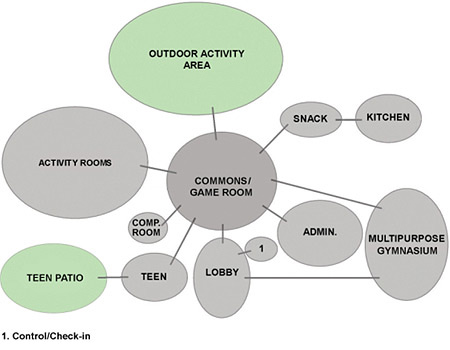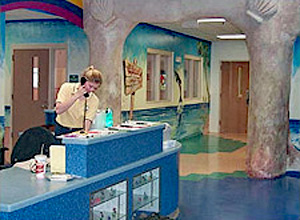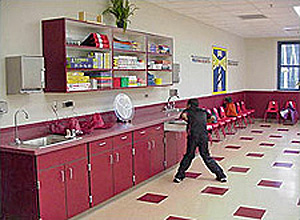Overview
Within This Page
The Youth Center is a social and recreational center intended primarily for use by children ages 11 to 18 years. In some cases, children as young as six years old will use a Youth Center, but usually only if special programs are in place to accommodate them. The Center supports opportunities for youth to develop their physical, social, emotional, and cognitive abilities and to experience achievement, leadership, enjoyment, friendship, and recognition.
The Youth Center offers organized instructional programs for physical activities such as dance, yoga, and martial arts and for academic and arts programs such as science, crafts, and theater. It also offers opportunities for unstructured activities such as game playing, socializing, club meetings, and outdoor play.
While unstructured activities are an essential part of a Youth Center, these are staffed facilities and control and supervision are critical elements. These elements impact facility design as do considerations for youth-friendly and youth-appealing design. Safety is also of paramount importance.
Several nationally recognized accreditation agencies identify requirements for programs and facility conditions: National AfterSchool Association (NAA), formerly the National School-Age Care Alliance, and the National Association for the Education of Young Children (NAEYC). Also, the National Institute on Out-of-School Time (NIOST) provides training and curriculum development.
Building Attributes
A. Space Types and Building Organization
A Youth Center serves the dual purpose of accommodating unstructured social interaction among different age groups and providing instructional classes all in a safe, supervised environment. This drives the facility layout and functional space adjacencies.

Sample adjacency diagram for a youth center.
Developed by DMJM Design, Arlington, VA
Typical Youth Center activity spaces include the following:
- Control desk/check-in
- Commons/game room
- Snack bar
- Activity rooms/classrooms
- Multipurpose room/gymnasium
- Computer room
- Teen room and
- Outdoor activity areas.
Typical Youth Center support spaces include the following:
- Administrative office space
- Toilets and janitor facilities
- Kitchen and
- Mechanical/electrical/communications space.
It is particularly effective to organize the activity spaces around the Commons-making it the heart of the program area around which the other program spaces revolve. The Commons area is the principal social gathering point and fulfills many of the social interaction goals of the facility. It usually includes subareas such as a game area, an eating area (adjacent to the snack bar), a television (TV) viewing area, and general gathering/conversation spaces. These subareas should accommodate social units of 12 to 15 youth gathering in pockets.
The Commons should naturally "grow" out of the lobby, past the control desk. The control desk should have visual control over the entire Commons and any entrances to other spaces. The entrances to the other activity spaces should be well defined and act as portals to those areas.
The snack bar can range from self-service vending stations to a full-service hot bar with an adjacent teaching kitchen that also serves an instructional function. It should be adjacent to an eating area in the Commons.
The activity rooms can range from small classroom spaces to a full-sized gymnasium, depending on facility mission, programs offered, and available budget. Typically at least two activity rooms should be provided: one configured for more academic or arts and crafts instruction and one configured for physical activities.
If mission and budget allow for a large activity room (or multipurpose room), design the room to meet high school or college standards for a gymnasium to provide maximum utility and flexibility. Provide either a separate, exterior entrance or an entrance directly off the lobby into the gymnasium. This facilitates access to this room for after-hours sporting events when the rest of the facility is closed.
A computer room provides the youth with supervised computer and Internet access for recreation and homework purposes.
The teen room provides a separate space for older youth to socialize independently from the rest of the facility. It provides functions similar to those of the Commons area and should include space for games, TV watching, and conversation. Ideally, the teen room should feel private but maintain a sense of connection to the rest of the facility.


Youth Center Control Desk, Naval Station Mayport, FL.
Photo by Mayport MWR Department
Arts-and-crafts-style Activity Room, Naval Station Mayport.
Photo by Mayport MWR Department
B. Design Considerations
Key design goals and considerations for Youth Centers include the following:
Create a Homelike Environment
While meeting the durability requirements for a public facility, the finishes, furnishings, fixtures, and equipment in Youth Centers should be comfortable and have a homelike quality:
- Provide ample natural light
- Provide a sense of welcome and arrival at the entrance, lobby, and control desk
- Use residential-style doors and windows
- Use indirect lighting as main ambient lighting, and
- Avoid institutional, unnatural finishes, textures, and colors.
Encourage Creativity
Part of the facility's mission is to encourage creative development. The project development process and final design can help accomplish this in several ways:
- Carefully consider interior colors and textures. Design the Youth Center to communicate a sense of fun, but use restraint (e.g., neutral tones for backgrounds and ceilings, with warm colors for accents). Consider wall murals in some common areas.
- Particularly for the teen room, consider guiding a teen focus group to select an interior color scheme
- Provide space and consider various techniques to display and celebrate youth artwork, and
- Design display areas to be easily changed and updated, minimize permanent graphics.
Encourage Autonomy
Youth centers are not schools. While supervision must be maintained at all times, the design should accommodate autonomy in the unstructured activity areas. The youth patrons should have independent access to the following:
- Snack bar and toilets
- Games, computers, and TV
- Friends and companions, and
- Quiet space for solitude.
Include Appropriate Space for Staff
Provide space to assist staff in developing and maintaining the center's programs and business. Outside of normal day-to-day operations, staff must be able to accomplish the following:
- Think and plan
- Meet and communicate
- Host visitors, and
- Store equipment and records.
Maintain a Safe and Healthy Environment
Design the facility to accommodate equipment and operational strategies to both protect the youth and maintain a healthy environment. Consider the following critical elements:
- Prevent unauthorized access by potentially dangerous personnel
- Provide visual access to all spaces to monitor potential child abuse situations
- Provide easily-cleaned finishes
- Use non-toxic building materials and improved maintenance practices
- Ensure good indoor air quality and abundant natural light, and
- Ensure that equipment, furnishings, and finishes do not contain asbestos or lead.
Relevant Codes and Standards
Youth Centers are not as carefully regulated as child care facilities, but many of the same standards may apply and, at a minimum, should be reviewed for information and insight. The DoD has additional criteria specific to their Youth centers that go beyond what the private sector may require. Therefore, additional DoD requirements have been included below.
Federal Mandates and Criteria
- Executive Order 13693, "Planning for Federal Sustainability in the Next Decade"
- DoD Instruction 6060.2 Child Developement Programs (CDPs)
- DoD Instruction 6060.4 Youth Programs
- UFC 4-740-06 Youth Centers
Standards and Guidelines
- ASTM F-355 Standard Test Method for Impact Attenuation of Playing Surface Systems, Other Protective Sport Systems, and Materials Used for Athletics, Recreation and Play
- Consumer Product Safety Commission, Public Playground Safety Handbook
- EPA Comprehensive Procurement Guidelines for Park and Recreation Products
Additional Resources
Organizations
- National AfterSchool Association (NAA)—A professional association dedicated to the development, education, and care of children and youth during their out-of-school hours
- National Association for the Education of Young Children (NAEYC)—An advocacy organization for preschool care and education
- National Collegiate Athletic Association (NCAA)—Serves as a governance and administrative structure for collegiate athletics
- National Federation of State High Schools (NFHS)—Provides national coordination for the administration of interscholastic activities
- National Institute on Out-of-School Time (NIOST), at the Center for Research on Women at Wellesley College—An advocacy organization for programs serving children and youth
Publications
- Developmentally Appropriate Practice in Early Childhood Programs Serving Children from Birth Through Age 8, 3rd Edition, by Carol Copple and Sue Bredekamp, eds., National Association for the Education of Young Children
- The NAA Standards for Quality School-Age Care, The National AfterSchool Association








